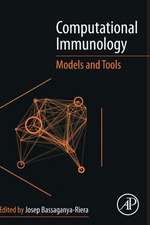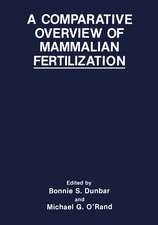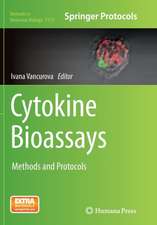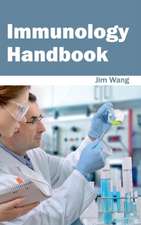Two-Dimensional Electrophoresis and Immunological Techniques
Autor Bonnie S. Dunbaren Limba Engleză Paperback – 31 iul 1988
Preț: 372.97 lei
Preț vechi: 392.60 lei
-5% Nou
Puncte Express: 559
Preț estimativ în valută:
71.38€ • 73.74$ • 59.40£
71.38€ • 73.74$ • 59.40£
Carte tipărită la comandă
Livrare economică 26 martie-09 aprilie
Preluare comenzi: 021 569.72.76
Specificații
ISBN-13: 9780306428395
ISBN-10: 0306428393
Pagini: 383
Ilustrații: 383 p. 111 illus.
Dimensiuni: 152 x 229 x 21 mm
Greutate: 0.52 kg
Ediția:Softcover reprint of the original 1st ed. 1987
Editura: Springer Us
Colecția Springer
Locul publicării:New York, NY, United States
ISBN-10: 0306428393
Pagini: 383
Ilustrații: 383 p. 111 illus.
Dimensiuni: 152 x 229 x 21 mm
Greutate: 0.52 kg
Ediția:Softcover reprint of the original 1st ed. 1987
Editura: Springer Us
Colecția Springer
Locul publicării:New York, NY, United States
Public țintă
ResearchCuprins
1 Basic Theories and Principles of Electrophoresis.- I. Introduction.- II. Basic Principles of Electrolysis.- III. Movement of Molecules in an Electrical Field.- IV. Choice of Buffers for Electrophoresis.- V. Basic Types of Electrophoresis.- A. Moving Boundary Electrophoresis.- B. Zone Electrophoresis.- C. Continuous Electrophoresis.- VI. Movement of Molecules in Support Media during Electrophoresis.- VII. Basic Principles of Isoelectric Focusing.- A. Definition of Isoelectric Point.- B. Definition of Ampholytes.- C. Experimental Parameters Affecting Measurement to Apparent Isoelectric Points of Proteins.- D. Determination of pH in Isoelectric Focusing Gels.- E. Equilibrium versus Nonequilibrium Isoelectric Focusing.- VIII. Basic Principles of Polyacrylamide Gel Electrophoresis.- A. Acrylamide Gel Matrix.- B. Role of Catalysts (Initiators) in Acrylamide Polymerization.- C. Acrylamide Pore Size.- D. Effect of Acrylamide Pore Size on Separation of Proteins.- IX. Principles of a Stacking Gel.- X. Sodium Dodecyl Sulfate—Polyacrylamide Gel Electrophoresis.- XI. High-Resolution Two-Dimensional Polyacrylamide Gel Electrophoresis.- References.- 2 Applications and Strategies for Use of Polyacrylamide Electrophoresis.- I. Introduction.- II. Nonreducing Polyacrylamide Gel Electrophoresis.- III. One-Dimensional Sodium Dodecyl Sulfate-Polyacrylamide Gel Electrophoresis.- IV. When to Use Two-Dimensional Polyacrylamide Gel Electrophoresis.- V. Peptide Mapping.- A. One-Dimensional Peptide Mapping.- B. Two-Dimensional Peptide Mapping.- C. Limitations of Peptide-Mapping Techniques.- VI. Purification of Proteins from Polyacrylamide Gels.- VII. Obtaining Peptides for Amino Acid Sequence.- VIII. Preparation and Characterization of Antibodies Purified by Polyacrylamide GelElectrophoresis.- IX. Analysis of Posttranslational Modification of Proteins.- X. Comparison of Complex Protein Samples.- XI. Use of Modified Electrophoresis Systems to Analyze Specific Proteins.- XII. Clinical Applications of Two-Dimensional Polyacrylamide Gel Electrophoresis.- References.- 3 Sample Preparation for Electrophoresis.- I. Quantitation of Protein in Samples.- II. Principles of Protein Solubilization.- III. Experimental Solubilization of Protein Samples.- A. Denaturation by Urea.- B. Denaturation by Guanidinium Chloride.- C. Denaturation by Detergents.- D. Solubilization of Membrane Proteins.- IV. Factors Critical for Sample Solubilization prior to Isoelectric Focusing.- V. Artifacts of Protein Solubilization.- A. Detergent Concentration and Interaction.- B. Chemical Modification of Proteins.- C. “Insoluble” Proteins.- VI. Subfractionation of Samples for Electrophoresis.- A. Organelle Fractionation Using Centrifugation and Electrophoresis.- B. Water-Soluble Fractionation.- C. Chemical Extraction Methods for Protein Analysis.- D. Differential Absorption of Proteins to Charged Matrices.- References.- 4 Protein Detection in Polyacrylamide Gel Electrophoresis.- I. Introduction.- II. Coomassie Blue Staining Methods.- III. Silver Staining of Proteins in Polyacrylamide Gels.- A. Introduction.- B. Factors Affecting Silver Stain Reactions.- C. Molecules and Artifacts Stained by Silver Stain Methods.- IV. Miscellaneous Protein-Staining Methods.- References.- 5 Basic Principles of Posttranslational Modification of Proteins and Their Analysis Using High-Resolution Two-Dimensional Polyacrylamide Gel Electrophoresis.- I. Introduction.- II. Protein Glycosylation.- A. Definitions and Basic Structures.- B. Protein-Carbohydrate Linkages.- C. Synthesis and Processing ofGlycoproteins.- D. Effects of Glycosylation on the Physicochemical and Biochemical Properties of Proteins.- E. Carbohydrate Side-Chain Heterogeneity.- F. Analysis of Glycoproteins Using Two-Dimensional Polyacrylamide Gel Electrophoresis.- G. Deglycosylation of Glycoproteins.- III. Protein Phosphorylation.- A. Introduction.- B. cAMP-Dependent Protein Phosphorylation.- C. cAMP-Independent Protein Phosphorylation.- D. Experimental Identification of cAMP-Dependent Protein Kinases Using Polyacrylamide Gel Electrophoresis.- E. Experimental Identification of Endogenous Substrates for Protein Kinases.- F. Tyrosine-Specific Protein Kinases.- References.- 6 Isotopic Labeling of Proteins for Electrophoretic Analysis.- I. Introduction.- II. Amino Acid Labeling during Protein Synthesis.- A. Advantages of Radiolabeling Proteins.- B. Disadvantages of Radiolabeling Proteins.- C. Equilibrium, Pulse, and Pulse-Chase Labeling Studies.- D. Use of Protein Synthesis Inhibitors in Radiolabel Studies.- E. Interpretation of Radiolabeling Experiments.- III. Radiolabeling Using Protein Phosphorylation Methods.- IV. Carbohydrate Labeling of Glycoproteins.- V. Labeling of Proteins by Chemical Modification.- References.- 7 Use of Autoradiography in Polyacrylamide Gel Electrophoresis.- I. Introduction.- II. Isotopes Commonly Used in Autoradiography.- III. Emulsions and Films Used in Autoradiography.- IV. Formation of an Autoradiographic Image.- V. Exposure Methods for Autoradiography.- A. Direct Exposure Method.- B. Fluorography Method.- C. Intensifying Screens.- D. Use of Hypersensitized or Preexposed Film.- E. Exposure of X-Ray Film at Low Temperature.- References.- 8 Strategies for Use of Polyacrylamide Gel Electrophoresis in the Preparation and Characterization of Antibodies.- I. Introduction.-II. Strategies for Developing Antibodies.- A. Polyclonal Antibodies.- B. Monoclonal Antibodies.- III. Immunization Protocols.- A. Choice of Antibody.- B. Guidelines for Choosing Animal Species to Be Immunized.- C. Choice of Adjuvant.- D. Preparation of Polyacrylamide Gel for Immunization.- E. Routes of Administration.- F. Dosages for Immunization.- G. Enhancement of Immunogenicity of Proteins.- H. Immunization Procedures for Obtaining Ascites Fluid.- IV. Collection of Blood and Ascites Fluid for Antibody Preparation.- A. Bleeding Procedures.- B. Collection of Ascites Fluid.- V. Immunoglobulin Purification.- A. Immunoglobulin Fractionation.- B. Immunoglobulin Characterization by One- and Two-Dimensional Polyacrylamide Gel Electrophoresis.- VI. Methods for Antibody Detection.- A. Introduction.- B. Immunoprecipitation Methods.- C. Solid-Phase Assays.- References.- 9 Practical Methods for Laboratory Photography.- I. Introduction.- A. Cost Effectiveness and Efficiency.- B. Immediate and Complete Data Storage.- C. Accurate Data Recording.- II. Choice of Photographic Methods.- A. Choice of Camera.- B. Choice of Lens.- C. Choice of Film.- D. Choice of Filters.- III. Bulk Loading Film.- IV. Photographing Polyacrylamide Gels.- A. Photographic Setup.- B. Photographic Composition.- C. Film Exposure Conditions.- V. Developing Film.- A. Photographic Paper.- B. Print Exposure.- C. Print Development.- VI. Printing Photographs from Negatives.- A. Equipment.- VII. Direct Contact Prints of Color-Based Silver-Stained Polyacrylamide Gels.- References.- 10 Troubleshooting and Artifacts in Two-Dimensional Polyacrylamide Gel Electrophoresis.- I. Introduction.- II. Reagent Quality and Equipment Maintenance.- A. Water.- B. Chemicals.- C. Equipment Maintenance.- III. Isoelectric Focusing.- A. Sample Solubilization.- B. Problems with Gel Polymerization.- C. Problems with Removal of Gels from Tubes.- D. Gel Breakage during Isoelectric Focusing.- E. Irreproducible Isoelectric Focusing Patterns.- IV. Sodium Dodecyl Sulfate Slab Gel Electrophoresis.- A. Gel Polymerization.- V. Problems with Staining Gels.- A. Coomassie Blue Staining.- B. Problems Associated with Silver-Staining Procedures.- C. Staining Artifacts.- VI. Troubleshooting Immunoblotting Methods.- A. High Background.- B. Uneven Background or Splotches on Transfer.- C. Little or No Antibody Binding to Proteins.- D. Irregular Transfer of Protein to Nitrocellulose.- VII. Conclusions.- References.- 11 Advances in Technology of High-Resolution Two-Dimensional Polyacrylamide Gel Electrophoresis.- I. Introduction.- II. Equipment and Reagents for Isoelectric Focusing.- A. Isoelectric Focusing Using Horizontal Slab Apparatus.- B. Isoelectric Focusing Using a Gel-Tube Apparatus.- C. Reagents Used for Isoelectric Focusing.- III. Equipment for Second-Dimension Polyacrylamide Slab Gel Electrophoresis.- A. Uses of Standardized Equipment.- B. Standardization of High-Resolution Two-Dimensional Polyacrylamide Gel Electrophoresis.- C. Specialized Equipment for Slab Gel Electrophoresis.- IV. Computerized Analysis of One- and Two-Dimensional Polyacrylamide Gel Electrophoresis.- V. Commercial Availability of Precast Gradient Gels and Gel Analysis Services.- References.- Appendixes.- 1. Protein Assays.- 2. Sample Preparation and Solubilization for One-Dimensional Polyacrylamide Gel Electrophoresis and Isoelectric Focusing.- 3. Method for Isoelectric Focusing.- 4. Preparation of Slab Gels for One- or Two-Dimensional Polyacrylamide Sodium Dodecyl Sulfate Gel Electrophoresis.- 5. Loading the Isoelectric Focusing Gel and CarryingOut Second-Dimension Electrophoresis.- 6. Methods for Studying Protein Phosphorylation.- 7. Fluorography.- 8. Drying Gels for Autoradiography.- 9. Methods for Staining Proteins in Polyacrylamide Gels.- 10. Methods for Deglycosylation of Glycoproteins.- 11. Antibody Preparation, Detection, and Characterization Techniques.- 12. Electrophoretic Transfer of Proteins to Nitrocellulose: Immunoblotting and Lectin Blotting.- 13. Electroelution of Proteins from Polyacrylamide Gels.- 14. Photography of Polyacrylamide Gels and Development of 35-mm Film.- 15. Direct Color Contact Printing from Polyacrylamide Gels.- 16. Addresses of Major Equipment Suppliers.






















